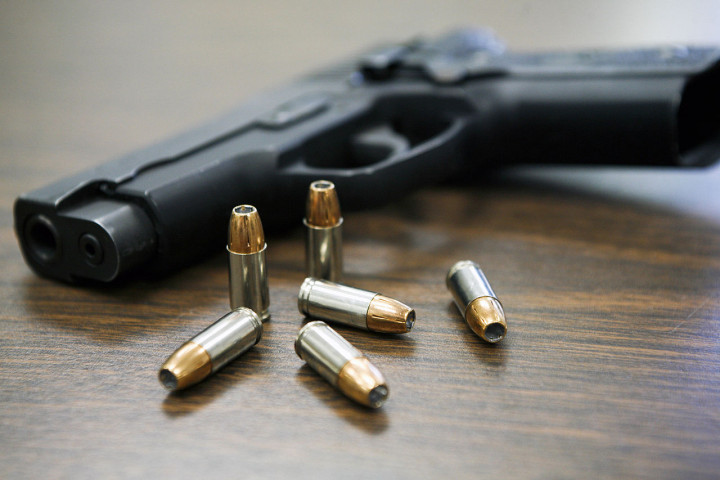Small arms—guns, rifles, etc.—are a key part of the global armed violence epidemic, resulting in about half a million deaths annually. They are, as activist Daniel Mack wrote recently, “the main vector of death and injury worldwide.”
The manufacture, trade, proliferation, possession, and use of small arms facilitate gender-based violence, sexual violence, domestic violence, mass shootings, human trafficking, and armed conflict. They are also key factors in the development and perpetuation of violent masculinities and the militarisation of communities.
These challenges affect all of WILPF’s work on disarmament, human rights, and women, peace and security. This is why over the next few days we will be writing about guns during the 2016 Global Week of Action Against Gun Violence, which runs from 1 to 8 May.
Hosted by the International Action Network on Small Arms (IANSA), the week of action is an opportunity to highlight the international campaign to stop the proliferation and misuse of small arms, promote the effective implementation of the United Nations Programme of Action on the illicit trade in small arms and light weapons (UNPoA), and raise awareness of the epidemic of gun violence and its consequences. The theme of this year’s week of action is “Time to End the Deadly Flood of Guns”.
Gender-based gun violence
Our work on challenging the international arms trade is a key part of WILPF’s contribution to this theme of ending the flood of guns. We worked with IANSA Women’s Network during the negotiation of the Arms Trade Treaty (ATT) to secure a legally-binding provision mandating arms export risk assessment processes to look at the risk of the weapons being used to commit or facilitate acts of gender-based violence.
Some people working on the treaty negotiations did not immediately recognise the link between the trade in weapons and gender-based violence. But every gun that is used, to commit any form of violence, came from somewhere—it was produced, and then in many cases, transferred across borders. And there are clear links between the possession of small arms, both inside and outside of armed conflict, and the commission of acts of gender-based violence.
The UN Secretary General has highlighted this link for years in his reports to the UN Security Council. In his 2015 report, he noted, “Sexual and gender-based crimes are often perpetrated by armed individuals. Increased military or armed group activity can bring a greater risk of attack.” The use of guns to facilitate rape in war has been documented increasingly in many different conflicts, from Bosnia to South Sudan and beyond.
But small arms also facilitate and aggravate domestic violence. Domestic homicides are the only category of homicides for which women outnumber men as victims. In countries with low rates of female homicide, most killings of women occur in the home, and intimate partners account for the majority, sometimes over 60%, of perpetrators.
LGBT people are also victims of gender-based violence. In 2015, more transgendered people were killed in the United States than any other year on record. Most of the victims were transgendered women of colour. While statistics on weapons used to commit GBV or murder LGBT people are difficult to find, a survey of reports indicates firearms are frequently used.
Culture of weapons
WILPF has recently published a new report looking at how states can implement the provision of the ATT that aims to prevent gender-based violence. But the problem with gun violence goes beyond the arms trade or the illicit trafficking in weapons. Guns are reflective of a culture of aggression and impunity. “Guns do not need to be fired to be effective,” Michael Ashkenazi of the Bonn International Center for Conversion argues. “The carrying of a gun often symbolises its use, or substitutes for its use far more effectively than does actual use, provided the willingness of the user to actually fire the weapon has been established.”
This sounds very similar to the culture of nuclear weapons. A handful of states that possess nuclear weapons act as if the mere possession of these weapons of terror affords them a privileged position of authority, dominance, and security over the rest of us. They purport that nuclear weapons offer the world stability and safety when in reality they leave us all living under the threat of annihilation.
With the open-ended working group on nuclear disarmament about to begin its second session for the year, this is an important parallel to draw. Weapons—small arms or nuclear arms—are about power, not security. They are about control and dominance, not cooperation or equality. They in fact undermine security, cooperation, and equality. They detract from our collective humanity, facilitating divisions and violence. We can see the trajectory of military technology taking us further in this direction, with the deployment of armed drones and the development now of lethal autonomous weapon systems.
Activism and advocacy
WILPF seeks to address the challenges posed by all of these weapons and the culture of violence and militarism through its work on disarmament and arms control. We recently participated in a meeting on autonomous weapons and now we’re covering the nuclear weapon working group. In June WILPF will participate in the sixth meeting of states addressing the implementation of the UN Programme of Action on the illicit trafficking of small arms and light weapons.
We will be hosting an event on our new report looking at how the UNPoA and Arms Trade Treaty can help prevent gender-based violence. We will also monitor and report on the meeting and archive statements and other documents. Subscribe now to receive the Small Arms Monitor daily during the meeting, 6–10 June! And stay tuned to WILPF’s blog for more articles on gun violence over the next week!










